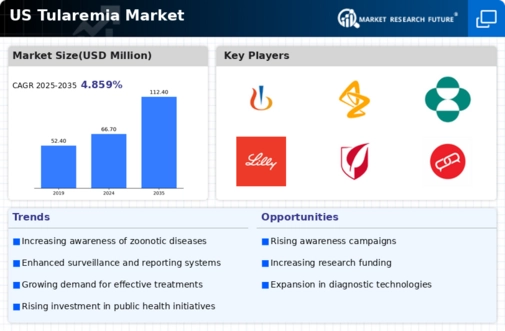Growing Veterinary Concerns
The increasing awareness of tularemia in animal populations is influencing the tularemia market. As tularemia can affect various animal species, including pets and livestock, veterinarians are becoming more proactive in diagnosing and managing the disease. This heightened focus on veterinary health is likely to drive demand for diagnostic tools and treatments that can be used in animals. The veterinary sector's involvement in addressing tularemia may also lead to increased collaboration between human health and animal health sectors, fostering a more comprehensive approach to disease management. Consequently, the tularemia market may benefit from this cross-sector collaboration, as it could lead to advancements in both human and veterinary medicine.
Research and Development Investments
Investments in research and development (R&D) are pivotal for the advancement of the tularemia market. Pharmaceutical companies and research institutions are increasingly allocating funds to develop new therapeutics and vaccines for tularemia. In 2025, it is estimated that R&D spending in this area could reach upwards of $50 million, reflecting a growing commitment to addressing this infectious disease. The focus on innovative treatment options, including monoclonal antibodies and novel antibiotics, is expected to enhance the market landscape. Additionally, collaborations between public and private sectors may further accelerate the pace of R&D, leading to breakthroughs that could significantly impact the tularemia market. This investment trend suggests a robust future for the industry as new products emerge.
Increased Incidence of Tularemia Cases
The rising incidence of tularemia cases in the US is a critical driver for the tularemia market. Recent data indicates that the number of reported cases has increased by approximately 20% over the past five years. This uptick in cases is likely due to various factors, including environmental changes and increased human-animal interactions. As awareness of tularemia grows, healthcare providers are more vigilant in diagnosing and reporting cases, which may further contribute to market growth. The increased incidence necessitates the development of effective treatment options and diagnostic tools, thereby stimulating demand within the tularemia market. Furthermore, public health campaigns aimed at educating communities about the disease may also play a role in increasing case detection and reporting.
Public Health Preparedness Initiatives
Public health preparedness initiatives are increasingly shaping the tularemia market. In light of emerging infectious diseases, health authorities are prioritizing the development of response strategies for potential outbreaks, including tularemia. These initiatives often involve enhancing surveillance systems, improving diagnostic capabilities, and ensuring the availability of effective treatments. As funding for public health preparedness grows, it is anticipated that the tularemia market will experience a boost in demand for products that support these initiatives. Furthermore, the emphasis on preparedness may lead to increased training for healthcare professionals, ensuring they are equipped to recognize and respond to tularemia cases effectively. This proactive approach could ultimately strengthen the market's resilience against future challenges.
Regulatory Support for Treatment Approvals
Regulatory support from agencies such as the FDA is a significant driver for the tularemia market. The streamlined approval processes for new treatments and diagnostics can facilitate quicker access to essential therapies for patients. In recent years, the FDA has prioritized the review of treatments for infectious diseases, which may include those targeting tularemia. This regulatory environment encourages pharmaceutical companies to invest in the development of new products, knowing that they may receive expedited approval. As a result, the tularemia market could see an influx of innovative therapies that address unmet medical needs, ultimately improving patient outcomes and expanding market opportunities.

















Leave a Comment